Summary of Collage
A common technique practiced by decorators, advertising agencies, and hobbyists alike, collage upended the fine-art world when Cubists Georges Braque and Pablo Picasso incorporated bits of newspaper and printed wallpaper into their paintings, subverting traditional definitions of what is important art. Combining painting, real-world objects, images, and ephemera into a single work, collage directly questions the tendency to separate fine art from everyday objects, the delineations between so-called high and low culture, and the status of the artist.
Adopted by subsequent artists, collage became a dominant technique in the Dada, Surrealist, Pop Art, and Neo-Dada movements, each using the technique to explore different subject matters. Because collage often incorporates mass-produced images, the practice is often inseparable from its historical and political context, making it a mode of powerful social commentary. Contemporary artists continue to explore the richness of collage in their efforts to question assumptions, biases, and pressing political crises.
Key Ideas & Accomplishments
- Whether purposefully or randomly composed, the juxtapositions between images and objects created by the collage technique have long intrigued artists. Because images can take on new meanings in new contexts, collage can subvert traditional meanings and at the same time multiply meanings, creating works that don't easily settle into single, fixed analyses.
- From the French meaning "to glue," collage describes the technique of composing an artwork by gluing a wide range of materials - including pieces of paper, fabric, newspaper clippings, and sometimes readymade objects - to a surface. Art historians make technical differentiations between collage techniques based on the materials an artist uses. Papiers collés are collages made only with bits of paper; decoupage, which means cutting, consists of cutting out colored paper or images and then gluing them to an object; photomontage uses photographs and images from mass-media sources, while assemblage is a three-dimensional accumulation of objects.
- Many avant-garde artists, from the earliest days of modernism to contemporary postmodernism, use collage to question the traditional role of the artist. By using found, often mass-produced, images and objects that the artists themselves don't make, collage undermines the traditional importance placed on the presence of the artist's hand in an original work of art. Additionally, often relying on chance to create compositions, many artists use collage to subvert the importance placed on the artist's creative genius in composing works.
The Important Artists and Works of Collage
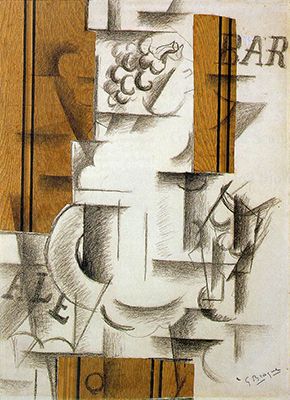
Fruit Dish and Glass
In this work pioneering work of collage, Braque combines faux-wood wallpaper with a Cubist depiction of a fruit dish and glass. The intersecting planes of the drawing and the collage elements upend traditional notions of perspectival space but still suggest a table top and a door, perhaps even suggesting a café. For Braque, Cubism's emphasis on still life was primarily concerned with depicting space, as he said, "What greatly attracted me - and it was the main line of advance of Cubism - was how to give material expression to this new space of which I had an inkling. So I began to paint chiefly still lifes, because in nature there is a tactile, I would almost say a manual space.... It was that space that attracted me strongly, for that was the earliest Cubist painting - the quest for space." While the papier collé still explores how we perceive and feel space, the addition of the glued-on bits of wallpaper emphasize a shallower space that is more an exploration of shapes, their tactility, and how they relate to each other.
Braque created this example of papier collé, which uses bits of paper instead of found images, while staying in Provence, after discovering a roll of wood-grain wallpaper in a shop window. He began cutting and pasting the paper into his drawings and shared the discovery with his friend and collaborator Picasso, who soon adopted the technique. During this period of time, the two men were working so closely together that Braque described them as "like two mountaineers roped together." Braque's papier collé became foundational for the proliferation of the collage technique.
Charcoal and cut-and-pasted printed wallpaper with gouache on white laid paper; subsequently mounted on paperboard - The Metropolitan Museum of Art, New York
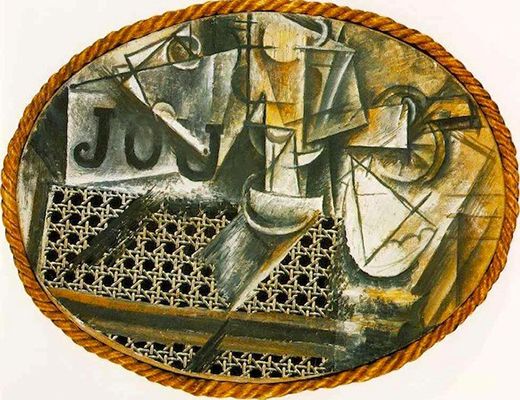
Still Life with Chair Caning
One of the first examples of Cubist collage, Still Life with Chair Caning depicts a multi-faceted view of a café table, chair, and various items - a knife, a napkin, part of a piece of fruit, and a wine glass. Instead of painting the chair, Picasso attached to the canvas surface a piece of oilcloth printed with a pattern of chair canning to suggest a chair, and used a length of rope to frame the canvas, suggesting a playful take on a table's customary carved edge. At the upper left, one sees the painted letters "Jou," both the French word for "game" and also an evocation of Le Journal, the daily newspaper that seems to be folded up on the table with a pipe resting atop it. While engaging in wordplay and visual punning, Picasso's collage makes viewers question their own perceptions of what constitutes an artwork as well as the relationship between art and ordinary objects.
Though he famously mastered subsequent styles, Picasso turned to collage throughout his career, as seen in his Maquette for the cover of the journal Minotaure (1933). Considered one of the most influential artists of the 20th century, Picasso's collages and collage constructions had a noted impact on subsequent art, not only in the mixing of high and low culture but also in its questioning of what constitutes art in the first place.
Oil and oilcloth on canvas, rope - Musée Picasso, Paris
Untitled (Collage with Squares Arranged according to the Law of Chance)
This abstract collage consists of blue and white torn squares in various sizes arranged on a grey background. Made of heavyweight paper, bits of the paper's fiber soften the edges of some of the squares, giving it more a hand-made feel while at the same time the loose grid of shapes feels more mechanical and mathematical. The artist Hans Richter described how Arp, after tearing up a drawing he'd been working on, "let the pieces flutter to the floor of his studio.... Sometime later he happened to notice these same scraps of paper as they lay on the floor, and was struck by the pattern they formed. It had all the expressive power that he had tried in vain to achieve.... Chance movements of his hand and of the fluttering scraps of paper had achieved what all his efforts had failed to achieve.... He accepted this challenge from chance as a decision of fate and carefully pasted the scraps down in the pattern which chance had determined."
Arp made this work in Zurich, the center of the emerging Dada movement. In the aftermath of World War I, Dadaists felt that traditional social systems and the emphasis on reason were responsible for the war and, as a result, they sought to free art from rational and intentional strategies and to create a new anti-art that was concrete and eschewed traditional notions of artistic genius. Closely working with his partner Sophie Taeuber, Arp said, "We painted, embroidered, and made collages. All these works were drawn from the simplest forms and were probably the first examples of concrete art. These works are realities pure and independent with no meaning or cerebral intention. We rejected all mimesis and description, giving free reign to the elementary and spontaneous." Arp's experiments with chance and collage were readily incorporated into other Dadaist techniques and later Surrealism and subsequently influenced a host of post-World War II artists who sought to subvert authorial intention and control.
Torn-and-pasted paper and colored paper on colored paper - The Museum of Modern Art, New York
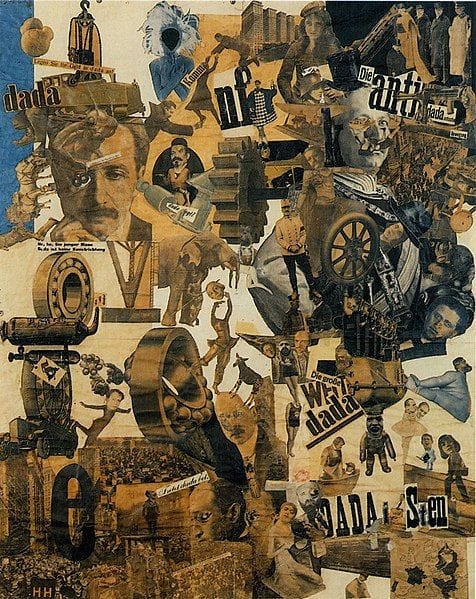
Cut with the Dada Kitchen Knife through the Last Weimar Beer-Belly Cultural Epoch in Germany
This Dada photomontage is composed entirely of newspaper and magazine clippings, showing a vision of Weimar society with its leading establishment and anti-establishment figures and its industrialized chaos. Shown at the 1920 First International Dada Fair in Berlin, the work was a huge success because of its legibility. As critic Brian Knight explains, "Ranged in the top right corner are the forces of 'anti-dada': stern representatives of the late empire, the army and the new Weimar government. Below, in the dada corner, are massed artists, communists and other radicals." The decentered and asymmetrical composition of disparate images reflects the Dada emphasis on, what art historian Peter Boswell called, "fracture and disjunction" and embodies a sense of anarchistic energy.
Höch said her pioneering technique was prompted by her discovery of postcards sent home by German soldiers in which they cut and pasted their heads on images of musketeers. These juxtapositions made her aware of how photomontage could "alienate" images from their original context. Additionally, her technique was also informed by her work, beginning in 1916, creating embroidery designs for women's magazines, where collage was a common technique. She was highly aware of the artistic potential of traditionally domestic handicrafts, as her 1918 manifesto on embroidery called on women to "develop a feeling for abstract forms."
Höch created photomontages for the rest of her career, saying, "there are no limits to the materials available for pictorial collages - above all they can be found in photography, but also in writing and printed matter, even in waste products." As art critic Harriet Baker wrote, her oeuvre challenged "the racist and sexist codes upholding Weimar Germany." Her work influenced her contemporary, the Surrealist Claude Cahun, and later artists such as Cindy Sherman.
Collage of pasted papers - Nationalgalerie, Staatliche Museen zu Berlin, Berlin
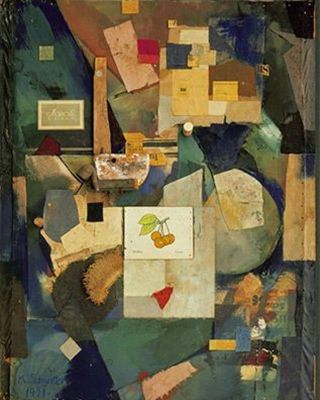
Merz Picture 32 A, The Cherry Picture
In this multi-layered work, areas of dark and light paint combined with glued-on bits of fabric, clippings, and candy wrappers create a sense of pictorial depth but also evoke something like a bulletin board covered in notes and cards. Combining detritus and traditional artistic media, Schwitters created an all-over, non-hierarchical composition. The inclusion of fragments, such as the broken pipe extending from the canvas, and a child's flashcard with the French and German words for cherry, blurs the boundaries between painting and ordinary objects. On the card, Schwitters has written the ungrammatical phrase "Ich liebe dir!" ("I love she!"), perhaps invoking his An Anna Blume (1919), a parodic love poem which made him famous.
Though he began his career as a Post-Impressionist, moving to a more Expressionist style, Schwitters took a radical new direction when he developed what he called Merzzeichnungen, or Merz drawings. As he said "Everything had broken down and new things had to be made out of the fragments; and this is Merz. It was like a revolution within me." He began incorporating trash collected from the streets into his works, saying, "I could not, in fact, see the reason why old tickets, driftwood, cloakroom tabs, wires, and parts of wheels, buttons and old rubbish found in attics and refuse dumps should not be a suitable material for painting as the paints made in factories."
Arp, who influenced Schwitters' turn toward collage, described the artist as "a wizard" and his studio as a "horrible beautiful Merz grotto where broken wheels paired with matchboxes, wire lattices with brushes without bristles, rusted wheels with curious Merz cucumbers." From 1923 to 1936 Schwitters used his collage technique to create Merzbau (Merz Construction), transforming his studio into an immersive environment. As he said, "Merz means to create connections, preferably between everything in this world." As art historian Gwendolen Webster wrote, "The language of Merz now finds common acceptance and today there is scarcely an artist working with materials other than paint who does not refer to Schwitters in some way. In his bold and wide-ranging experiments he can be seen as the grandfather of Pop Art, Happenings, Concept Art, Fluxus, multimedia art and post-modernism."
Cut-and-pasted colored and printed paper, cloth, wood, metal, cork, oil, pencil, and ink on board - The Museum of Modern Art, New York
Joy of Living
Evocative of a dingy interior, this collage, which includes pasted papers and fabric, remains resolutely abstract, as its elements evade signification. As Motherwell wrote, "One cuts and chooses and shifts and pastes, and sometimes tears off and begins again." Associated with the Abstract Expressionists, Motherwell's work is often considered in the trauma experienced in the wake of World War II. In 2013, art critic Holland Cotter described the collage as a "moody, unkempt concoction of smudged ink, nervy doodles and perspectival geometry, punctuated by a scrap cut from a military map and a sprinkling of curious red stains on a patch of white paper, like blood seeping through a bandage."
While studying at Columbia in 1940, Motherwell began to associate with Fernand Léger, Piet Mondrian, and leading French Surrealists who had fled the Nazi occupation. He became close friends with the artist Roberto Matta, who taught him Surrealist automatism and introduced him to Peggy Guggenheim, then forming The Art of This Century, her avant-garde gallery. She wanted Motherwell to participate in her 1943 collage exhibition, featuring Braque, Picasso, and Arp. At her and Matta's urging, the young artist created this collage, as he said, "I might never have done it otherwise, and it was here that I found . . . my 'identity.'" A great public success, Motherwell would go on to experiment with collage, making some of his most compelling work, including Pancho Villa, Dead and Alive and Blue and With China Ink (Homage to John Cage), and he continued with the technique throughout his decades-long career.
Oil, gouache, pasted fabric, pasted papers, crayon, charcoal, and ink on paperboard - Dedalus Foundation, New York
Dr. Pepper
With clippings taken from American mass media, the British Pop artist Eduardo Paolozzi used the technique of photomontage to probe the emerging post-World War II consumer society, which Paolozzi described as an "exotic society, bountiful and generous." New technology and products - a kitchen range, a new car, a Dr. Pepper bottle, and signage -combine with images of an alluring lifestyle - the attractive couple in a pool, the virile man on a motorcycle. For Paolozzi, living in a Britain still recovering from the war, its strict rationing, and economic hardship, these works were "where the event of selling tinned pears was transformed into multi-colored dreams, where sensuality and virility combined to form...an art form more subtle and fulfilling than the orthodox choice of either the Tate Gallery or the Royal Academy' Collage."
This work was part of BUNK! (1947-52), a series of 45 collages that art critic Frank Whitford described as juxtaposing "the weighty and trivial, the artistic and technological." Along with his colleague Richard Hamilton, Paolozzi explored Dadaist and Surrealist precursors and was fascinated with American advertising images from childhood. He compared his technique to 'introducing strange fellows to each other in hostile landscapes...without recourse to standard drawing and painting practice." Moving to Paris for a time, he was influenced by Dada and Surrealism, and also encountered the latest American publications brought over by servicemen. Even in his prints and sculptures, collage was central to Paolozzi's creations throughout his career. Paolozzi's collages would become important examples for later Pop Art throughout the world and postmodern explorations of consumer culture.
Printed papers on paper - Collection of the Tate, United Kingdom
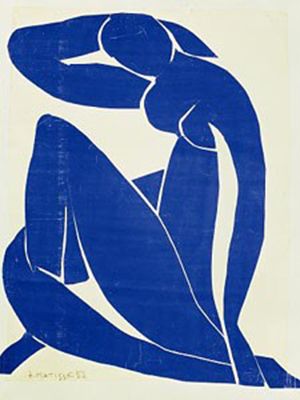
Blue Nude II
This découpage depicts a nude, her legs intertwined, her right arm curved around her head, and her left arm relaxed, hanging down to her side. The intense blue gouache of the painted, cut-out shapes creates a sense of weight, so the silhouette seems like a relief carved out of color. Matisse described the correlation of color and volume by saying, "To cut to the quick in color reminds me of the direct cutting of sculptors." The technique reflects Matisse's lifelong preoccupations with line and color, as he said, "My choice of colors...is based on observation, on feeling, on the very nature of each experience. I... merely try to find a color that will fit my sensation," and "my line drawing is the purest and most direct translation of my emotion."
One of a series of four Blue Nudes (1952), the work is a kind of culmination, evoking his Fauvist painting, The Blue Nude (1907) and the poses of his female figures in Le Bonheur de Vivre (The Joy of Life) (1905). Matisse first used paper cutouts for his design for Le Chant de Rossignol, a 1919 ballet production, and subsequently employed the technique for preliminary work, but began considering them as autonomous works in the early 1940s, when for health reasons he was confined to his bed and wheelchair.
His process involved working with a team of assistants, who would paint large rectangular sheets of paper with gouache, each color mixed to his instructions, and then he would select a sheet and, using long scissors, cut out forms. He would arrange the cutouts, his assistants pinning the composition on his studio walls, and then later gluing them. Art critic Adrian Searle wrote, he "created a universe that filled the room around him, spilling from the walls to the floor."
Gouache on paper, cut and pasted mounted on canvas - Fondation Beyeler, Basel, Switzerland
Monogram
With this work, Rauschenberg transformed the concept of two-dimensional collage into the three-dimensional realm. This iconic "combine" (Rauschenberg's preferred the term to assemblage) brings together a range of found objects, including a taxidermied Angora goat, its face daubed with bright paint, wearing a tire around its abdomen, standing on an abstract oil painting, made of two canvases. The effect is both startling and incongruous, as Rauschenberg said, "I wanted something other than what I could make myself and I wanted to use the surprise and the collectiveness and the generosity of finding surprises. And if it wasn't a surprise at first, by the time I got through with it, it was. So the object itself was changed by its context and therefore it became a new thing." Finding the goat in a local shop, Rauschenberg recognized its potential, but then as art historian Caroline Craft wrote, he "uncharacteristically spent four years trying to come up with a satisfactory way of incorporating it into a combine. He made sketches of possible solutions and photographed its various states.... At last, inspired by a suggestion from Jasper Johns, he placed the goat on a horizontal platform as if setting it out to pasture." The pasture includes other collage elements: a tennis ball, heel prints, and the addition of text.
After viewing an exhibition of Kurt Schwitters' work, Rauschenberg said, "I felt like he made it all just for me," and Schwitters' collages became a primary influence, informing what critics later called Neo-Dada. The combines were not Rauschenberg's first forays into assemblage. While traveling in Italy in the early 1950s, Rauschenberg made some of his first assemblages, incorporating discarded items he collected throughout his travels, but he destroyed most of them by throwing them into the Arno River. By 1954, he began creating his "combines," as they combined elements of painting and sculpture. As the Metropolitan Museum of Art wrote for his 2005 exhibition, "With these mixed-media works of art, Rauschenberg reinvented collage, changing it from a medium that presses commonplace materials to serve illusion into something very different: a process that undermines both illusion and the idea that a work of art has a unitary meaning."
Oil paint, paper, fabric, printed reproductions, metal, wood, rubber shoe-heel, and tennis ball on two conjoined canvases with oil on taxidermied Angora goat with brass plaque and rubber tire on wood platform mounted on four casters - Moderna Museet, Stockholm
Prevalence of Ritual/Conjur Woman No. 1
This collage depicts an African American woman, dressed in a long black robe and wearing a white turban as she faces the viewer with an intense and powerful gaze. A recognizable bird sits on her right shoulder, and a black avian shape on her other shoulder resembles a raven. The environment is composed of cutout images of foliage, dense overgrowth, and suggestions of a dilapidated house, its door and steps evoked behind her. Bearden's collage makes reference to his childhood fear of local conjure woman - a powerful figure who was known for her herbal remedies, various spells, and spiritual authority - who lived near his family in North Carolina.
This image is one of 21 small color collages that Bearden created out of pieces of cloth, magazine photographs, paper, and other materials. He then photocopied and enlarged the collages into black and white images that he called Projections (1964). He also felt the series was steeped in "the prevalence of ritual," writing, "I feel this continuation of ritual gives a dimension to the works so that the works are something other than mere designs." Jazz improvisation influenced Bearden's composition strategies. He explained, "In many ways it's like putting a symphony together, or a piece of music." Reproduced in black and white on a monumental scale, Bearden transformed collage into a medium equal to the large scale Abstract Expressionist works of the time. As art historian Mary Schmidt Campbell writes," Bearden's exhibition of Projections was widely hailed as a breakthrough. In choosing collage, Bearden intentionally selected a medium in which he could substitute the ready-made with the imaginative re-construction of the visual world. The works that followed are the product of a life that ran parallel to America's own struggle with old ways of seeing and knowing." Bearden was to describe the series' depiction of the South as "a homeland of my imagination."
In a New York Times obituary following Bearden's death, C. Gerald Fraser described him as "the nation's foremost collagist." The National Gallery of Art held a major retrospective of Bearden's work in 2003, and the Smithsonian Traveling Exhibition Service's Romare Bearden: A Black Odyssey toured the country in 2014-2015.
Gelatin silver print (Photostat) - The Museum of Modern Art, New York
You were always on my mind
This work depicts two heads in profile against a gray, cloudy background that darkens around the edges, creating a diaphanous glow surrounding the heads. The smaller head emerges as if from the mind of the larger head, which, painted in a pink and gray marbled effect, includes small cut-out images - an eye, a man wearing Middle Eastern clothing. The arm and hands of the larger head are also composed of cut-outs. Glitter and plastic beads are glued to the neck, and the twig-like forms emerging from the back of the head are made of wood-patterned plastic. The cut-outs are often organic - images of crustaceans in the arm and of fish and coral in the upper head - suggesting that these images and the world they represent are also "always on the mind" of the larger figure.
Kenyan-American artist Wangechi Mutu made this work in Brooklyn, innovatively using Melinex, a polyester film, for the painting's surface. It was exhibited at Yo.n.I, the artist's 2007 solo exhibition in London, the title explained by art historian Richard Martin as, "a reference to the Sanskrit word yoni that can mean 'divine passage,' 'place of birth' or 'sacred temple.' Many of the paintings in the show integrated cut-out images of plants, flowers and animals - taken from natural history magazines and the internet - within their depictions of human forms, as part of a wider exploration of fertility and reproduction."
Born and raised in Kenya, Mutu studied anthropology before studying art at Yale University, and her Pin-Up (2001) series, depicting women injured by political violence in Sierra Leone, was her first foray into collage. Mutu uses collage to explore the continued effects of colonialism in her native land as well as the experiences of the diaspora, or those who have left Africa to settle elsewhere. With these twin investigations, Mutu has created a powerful body of work that not only provides striking commentary on our contemporary, globalized era but also probes the formal aspects of the collage technique.
materials - Collection of the Tate, United Kingdom
Beginnings
Predecessors
By the 12th century, both the Chinese and Japanese routinely glued brightly colored pieces of paper to various objects, sometimes applying a layer of lacquer to seal the surface for more permanent effect. The technique spread to medieval Europe, where additional materials, such as shells, gemstones, or gold foil, were incorporated into compositions. By the 18th century, decoupage, from the French "to cut out," had become a popular pastime among the European aristocracy, including Madame de Pompadour, Marie Antoinette, and Beau Brummell. An 18th-century letter described the trend: "We are here in the height of a new passion for cutting up colored engravings.... These cuttings are pasted on sheets of pasteboard then varnished. We make wall panels, screens, and fireboards of them."
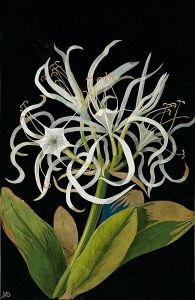
In the late 1700s, Mary Delany became famous for her works depicting flower specimens, which made her a favorite of the British court. After careful study of a particular flower, Delany often cut up hundreds of pieces of paper to create her life-like compositions. In 2019, art critic Claudia Massie declared that Delany's "Paper Mosaiks," as she called them, "pop off the walls with a vibrancy that belies the fact they were created 250 years ago from tiny shards of hand-tinted paper by an 'amateur' artist in her seventies."
Using paper clippings to create a variety of inventive and imaginative works became a dominant cultural trend by the Victorian era. Though the Royal Academy of Art did not recognize the art form, decoupage artists nonetheless often had a popular following, and their work feels more contemporary than ever. As Maisie wrote of the Victorian decoupage, "Presages of modernism abound. Photomontage is used extensively to create space-defying group portraits or deceptive illusions. A scrapbook of sliced-up words and portraits by Mary Watson, from 1821, reads like the chance poetry practiced 100 years later, and looks like some punky contructivist graphic." Simultaneously, by the end of the 1800s, popular magazines frequently combined images and fragments of images for advertisements. Culturally, the use of clippings for scrapbooks, cards, and decorative screens was ubiquitous by the dawn of the 20th century, though the practice was considered akin to a hobby, craft, or affiliated with the domestic realm, as seen in its widespread employment in women's fashion magazines.
Pablo Picasso and Georges Braque
While decoupage had a long history in Western folk art and decorative crafts, it was not until the experiments of Georges Braque and Pablo Picasso in the early 20th century that collage entered the lexicon of fine art. The two artists met in 1907 and worked closely with each other and together developed what would come to be known as Cubism. They experimented with still lifes and landscapes, breaking the composition into complex multifaceted perspectives.
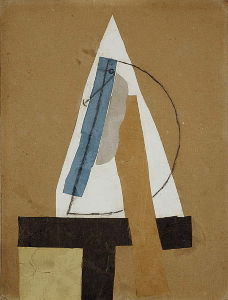
By 1912, more interested in the flat compositional aspects of the pictorial plane, Picasso and Braque began to explore collage, papier collé, and three-dimensional assemblages. In May 1912, Picasso incorporated a strip of oilcloth printed with a chair caning pattern into a painting and used a rope to frame the oval shaped canvas, and the resulting Still Life with Chair Caning (1912) pioneered collage as a fine art and launched a new phase of Cubism. In the summer of 1912, Braque and Picasso worked together in the South of France, when Braque, while wandering through Avignon, noticed a roll of wallpaper with a wood grain displayed in a shop window. Braque cut and pasted pieces of the paper into his Fruit Dish and Glass Sorgues (1912). After sharing the papier collé with Picasso, he said, "I felt a great shock and it was an even greater shock to Picasso when I showed it to him." A month later Picasso created Violin and Sheet of Music (1912), and for the next two years the artists' new Synthetic Cubism, as it came to be known, incorporated bits of paper from daily life into paintings and drawing, exploring the convergence of high and low, art and life, and the flatness of the picture plane.
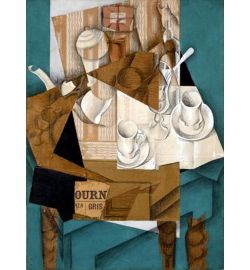
While Picasso and Braque took diverging paths in life and art after World War I, their discoveries were adopted widely by artists. Fascinated by Synthetic Cubism's use of papier collé, Juan Gris began experimenting with the technique in 1914. Incorporating paper with wood grain print, wallpaper scraps, and bits of newspaper, Gris created surfaces with multiple textures that played on the materiality of the work of art and the flatness of the canvas. He said of his papier collés, "I try to concretize that which is abstract.... My art is an art of synthesis.... I consider that the architectural side of painting is mathematical, the abstract side, I want to humanize it."
Dada and Collage
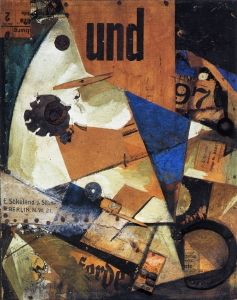
Following World War I, Dada emerged as one of the more radical European art movements. Declaring the Cubist emphasis on aesthetic formalism a dead end, Dadaism embraced and radically transformed collage. Hannah Hoch pioneered the avant-garde use of photomontage, a technique that, rather than using clippings of paper, employed images cut from mass media publications. In contrast, Hans Arp emphasized random chance to arrange torn squares of paper in abstract collages. Kurt Schwitters pioneered collages that he called Merz drawings, saying "merz" was a word he invented to mean "the combination of all imaginable materials for artistic purposes." Schwitters collected the detritus of everyday life, from candy wrappers to movie tickets to three-dimensional items, and composed entire works from these apparently "worthless" bits of ephemera to challenge the traditional values and perceptions of art and importantly moved ideas of collage into the realm of assemblage sculpture and installation.
Marcel Duchamp's concept of the readymade, in which he combined utilitarian objects to create art objects, can also be linked to experiments in three-dimensional collage, or Assemblage. Man Ray explored rayographs, a camara-less photographic technique of making collages, whereby he laid everyday objects directly on photo-sensitive paper and exposed it to light, thus creating ghostly silhouettes that seem both representational and abstract.
Rather than emphasizing still life as the Cubists had, Dadaists expanded the subject matter of collage to create portraits, multi-figure scenes, and social panoramas that pointed out the absurdity of political systems and figures. Dada collage had an extensive influence on Pop Art and post-World War II movements, including Assemblage, Happenings, and Performance Art.
Surrealism and Collage
Coming out of Dada, Surrealism also took up collage in its exploration of automatism and stream of consciousness in creating works. In many ways, collage as a medium was able to encapsulate André Breton's description of Surrealist dislocation, which he took from the writer Comte de Lautréamont: "the chance encounter of a sewing machine and an umbrella on an operating table. " Max Ernst experimented with various forms of collage to create eerie, dream-like compositions. He explained, "The collage technique is the systematic exploitation of the accidentally or artificially provoked encounter of two or more foreign realities on a seemingly incongruous level - and the spark of poetry that leaps across the gap as these two realities are brought together." For the Surrealists, the juxtapositions created by collage created exciting new meanings, provided a way to explore the unconscious workings of the mind, and tap into new subject matter.
Neo-Dada
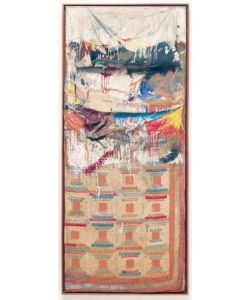
In the early 1950s, Neo-Dada marked a shift away from traditional painting in the postwar art world as Jasper Johns, Robert Rauschenberg, and Allan Kaprow turned away from Abstract Expressionism to emphasize the use of mass media, found objects, and performance. Their works often employed the technique of collage to challenge the distinctions between art mediums and to question artistic conventions. Influenced by Kurt Schwitters, Rauschenberg created Untitled (Man with White Shoes) (1954) by combining parts of old furniture, a taxidermied hen, various photographs, shoes, and gestural mark-making. Though it looks like a fairly straightforward encaustic painting, Johns' Flag (1954-5) was in fact a collage of newsprint, taken from advertisements and non-political articles, and strips of fabric. Neo-Dada's exploration of collage and Assemblage was consequential for contemporary experiments in Performance Art as well as Pop art.
Pop Art
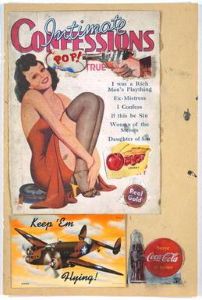
British Pop Art began in 1947 with Eduardo Paolozzi's collages, more accurately described as photomontages since they were composed of images cut from mass media magazines. Along with Richard Hamilton and Peter Blake, he explored, critiqued, and sometimes celebrated post-war consumer culture. Hamilton's Just What Is It That Makes Today's Homes So Different, So Appealing? (1956) is at once a parody and celebration of postwar domestic interiors, filled with new consumer goods and technology that promised a brighter future. American Pop artists such as Andy Warhol, and Roy Lichtenstein also drew on popular imagery, primarily emphasizing consumer and celebrity culture. James Rosenquist's painting President Elect (1960-61) combined partial images of a stale piece of cake, an automobile, and a smiling President John F. Kennedy to question the role of advertising in culture and how one takes in and processes the bombardment of images experienced everyday in the growing consumer culture.
Concepts and Trends
The nature of collage allows it to be incredibly versatile. Once artists began incorporating parts of everyday life into their paintings and compositions, there were no strictures on which materials they used, and as a result, various tendencies, or techniques, in collage developed and proliferated.
Collage and Sculpture: Assemblage
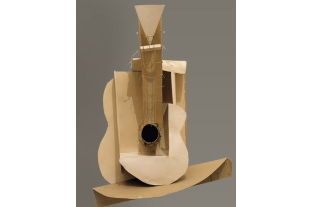
Braque pioneered collage construction sculptures with painted cardboard, but these works were lost during World War I, and so his contribution to this technique was overshadowed by Picasso, whose 1912 Maquette for Guitar is one of the earliest surviving three-dimensional Cubist collages. Throughout his career, Picasso made similar constructions, exploring new materials, such as wood, as seen in his Bull (1958) and metal, as in his Chair (1961).
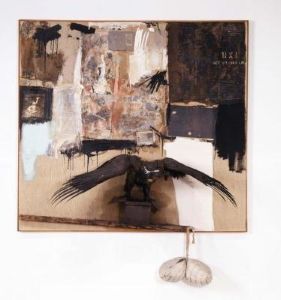
Later artists adopted and innovated three-dimensional collage, and the technique informed assemblages and works that blurred the boundaries between sculpture and painting. Kurt Schwitters developed his Merzbau (Merz Construction) (1923-37) from a column composed of newspaper clippings, detritus, and cardboard into a multi-room installation in his studio, creating an early immersive environment. Influenced by Schwitters, Robert Rauschenberg created what he called "combines," hybrids of painting and sculpture that incorporated everyday materials, as seen in his Canyon (1959).
In the 1940s, Louise Nevelson began creating works that have been variously described as sculptures, assemblages, and wood collages. Using readymade materials, such as crates, parts of discarded furniture, and architectural elements, she made large rectangular works, often painted in monochrome, exemplified by Sky Cathedral (1958).
Canvas Collage
Canvas collage involves gluing pieces of painted canvas patches to another canvas, Many Abstract Expressionists, including Lee Krasner and Conrad Marca-Reilli, employed this technique. In the early 1950s, frustrated with her painting process, Krasner tore up much of her current painting and drawing, but in the months ahead, she began creating new pieces out of these shards, gluing them onto other canvases and adding additional painted passages, as seen in Milkweed (1955). Marca-Relli's created canvas collages, in which he glued cutout pieces of painted canvas onto much larger canvases so that the interlocking curves and angles would emphasize what he called "the architecture of the human figure." Created on a monumental scale, his work influenced several of the Neo-Dada artists.
Photomontage
The German Dadaist Hannah Höch broke new ground with her photomontages, collages composed not of bits of plain paper but of various photographic images taken from mass media publications. The photomontage technique derived from fin de siècle popular culture when postcards and prints often combined images, and as art historian Kathy Halbreich noted, the Dadaists "enjoyed the mechanical - and proletarian - connotations associated with the term and used it to distinguish their work from Cubist collages, or papiers collés, whose formalist abstraction they considered a dead end." George Grosz, along with other Dadaists employed the technique, usually combining clippings of newspaper photographs and texts.

As Halbreich further noted, since the Dada movement "the term photomontage has often come to have a more restricted meaning: a seamless, composite image achieved either by manipulating negatives in the darkroom or re-photographing a collage of photographs, techniques favored by such disparate artists as John Heartfield and the Russian Constructivists, on the one hand, and the Surrealists, on the other." As a result, photomontage has become considered an independent art form, though artists have continued to explore the boundaries between photomontage and collage, as seen in Romare Bearden's Projections, which are enlarged black and white photostatic copies of his color collages.
Décollage
Décollage, a French word meaning to take off or lift-off, was first credited to Leo Malet, a Surrealist detective novelist, in the Dictionnaire Abrege du Surrealisme (1938) and defined as "the procedure that consists in tearing off parts of a poster in order to reveal fragments of the poster or posters...to disorient and lead astray." However, the term became primarily associated with Nouveau Réalisme, a 1950s French art movement, that included Raymond Hains, Jacques Mahé de la Villeglé, François Dufrêne, and the Italian artist Mimmo Rotella. Billboard posters, glued over one another and often torn or fragmented, were a common sight in urban environments. Of the posters in Rome, Rotella said, "I was literally spellbound, and even more so because at that time I was convinced that painting was finished, that something new had to be unearthed, something alive and modern." Artists tore away layers and fragments of these posters and then glued them onto a surface, as Rotella said, "leaving them exactly the way they were, exactly the way I saw them." Also called the torn poster technique, décollage both referenced society and evoked abstract, textured art works. Wolf Vostell, a German artist, connected the term to an airplane crashing during lift off, meaning that art should break down past signifiers to create new realities. In 1962 he launched De-coll/age: Bulletin Aktueller Idee, an experimental art and theory magazine, and in 1963 created his Nein 9 Decollagen (1963), lifting images from the television screen to place them in a new context.
Later Developments
The formal and critical power of various collage techniques continues to reverberate throughout the art world. By the 1960s, Duchamp's readymades and Schwitters's concept of Merz had profound consequences on the development of Assemblage and, later, Installation Art. And while not strictly engaged in collage, a collage aesthetic also informed much of the work of Photorealists like Audrey Flack, whose work often juxtaposes disparate, painted images, and the artists of the Pictures Generation, like Richard Prince, who appropriated mass-media imagery to create photomontages.
In the 21st century, college continues to be a vital technique for innovation, as seen in British Conceptual artist John Stezaker's work combining cut-up photographs from the 1950s in startling juxtapositions that challenge artistic and cultural conventions. Kenyan-American artist Wangechi Mutu' The Bride Who Married a Camel's Head (2009) uses collage to examine pressing contemporary concerns, including colonization, gender, and the environment. In his series of fantastical houses, Matthias Jung uses collage to reimagine architecture and its place in the landscape, and Jean-François Rauzier's work exploits digital technology to created altered images of cities and places, creating surreal and illogical compositions.
As artists continue to explore and push collage into new realms, the 2019 exhibition Cut and Paste: 400 Years of Collage held at the National Galleries of Scotland brought together modern and contemporary collages with works from the Victorian era and earlier, showcasing the deep history of the technique and attesting to the long, abiding fascination with collage's potential for play, discovery, critique, and questioning.
Useful Resources on Collage
-
![Georges Braque, Le Violon (1914)]() 8k viewsGeorges Braque, Le Violon (1914)Sotheby's
8k viewsGeorges Braque, Le Violon (1914)Sotheby's -
![Picasso Posse: Reordering of Reality]() 1k viewsPicasso Posse: Reordering of RealityPhiladelphia Museum of Art
1k viewsPicasso Posse: Reordering of RealityPhiladelphia Museum of Art -
![Robert Motherwell: Early Collages (2013)]() 27k viewsRobert Motherwell: Early Collages (2013)Our PickPeggy Guggenheim Collection
27k viewsRobert Motherwell: Early Collages (2013)Our PickPeggy Guggenheim Collection - Trains, snakes, and guitars: The collages of Romare Bearden (1980)Our PickSFMOMA
-
![Cubism: The Collaboration of Picasso & Braque (2014)]() 7k viewsCubism: The Collaboration of Picasso & Braque (2014)Aspen Institute / Talk by Leonard Lauder
7k viewsCubism: The Collaboration of Picasso & Braque (2014)Aspen Institute / Talk by Leonard Lauder -
![Guggenheim Robert Motherwell Lecture - Tearing Off and Beginning Again (2014)]() 8k viewsGuggenheim Robert Motherwell Lecture - Tearing Off and Beginning Again (2014)Guggenheim Museum / Catherine Craft Lecture
8k viewsGuggenheim Robert Motherwell Lecture - Tearing Off and Beginning Again (2014)Guggenheim Museum / Catherine Craft Lecture - Sunday at the Met - Robert Rauschenberg: Combines (2006)Conversation with Robert Rauschenberg and Calvin Tomkins














































